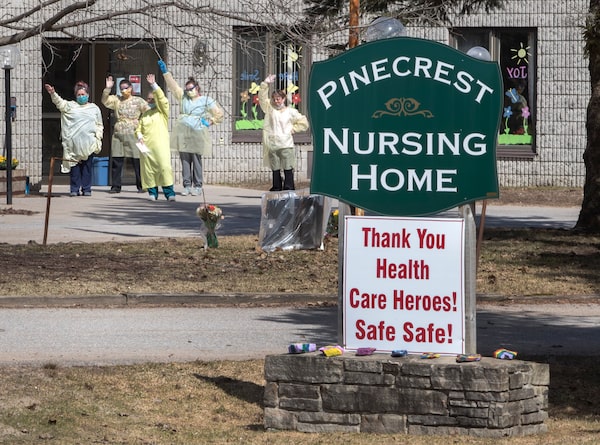
Nurses wave to hundreds of residents driving past Pinecrest Nursing Home honking to acknowledge health care workers in Bobcaygeon, On. on April 1, 2020.Fred Thornhill/The Canadian Press
Nathan Stall is a geriatrician at Sinai Health System (SHS) in Toronto and a research fellow at the Institute of Health Policy, Management and Evaluation at the University of Toronto.
Samir Sinha is the director of health policy research at the National Institute on Ageing (NIA) at Ryerson University, and the director of geriatrics SHS and the University Health Network in Toronto.
The Tragically Hip song Bobcaygeon is an iconic part of the Canadian musical canon, with Gord Downie singing of a town where constellations "reveal themselves one star at a time.” But this week, that small Ontario community that has carved an outsize space in the nation’s cultural firmament revealed something much more dire: just how vulnerable nursing homes are to the novel coronavirus pandemic.
Bobcaygeon’s Pinecrest Nursing Home has suffered a catastrophic outbreak of coronavirus that has killed 14 residents and one visiting spouse, with at least 24 staff members infected. It’s a tragedy workers at the home have likened to a “war zone.” Sadly, it’s not likely over yet, nor is this a unique case. The first major Canadian outbreak occurred in the Lynn Valley Care Centre in North Vancouver, and since then it has emerged in more than 600 care homes in Canada, and in more than 400 in the United States.
What are the coronavirus rules in my province?
Coronavirus guide: Updates and essential resources about the COVID-19 pandemic
This is a tragic repeat of what has occurred in European countries. Italian hospitals became so overwhelmed that nursing homes were left to fend for themselves, with so many residents left dead they are still not yet counted. In Spain, the military discovered “completely abandoned” nursing homes with residents found “dead in their beds.”
Now, nursing homes are considered “ground zero” for North America’s COVID-19 pandemic.
The reasons begin with demographics. At least 400,000 Canadians live in residential care homes, and the average nursing home resident is 82 years old, suffers from multiple medical conditions, and takes 10 medications a day. Almost 70 per cent have a diagnosis of dementia, with the majority requiring around-the-clock care to support activities such as toileting, feeding and getting out of bed. The new coronavirus has a predilection for older adults and those with chronic conditions, resulting in a stunning case-fatality rate of 33.7 per cent among nursing-home residents.
Dementia makes identifying a case of COVID-19 particularly challenging, since diagnosing it often relies on the individual recognizing and reporting symptoms. Frail older adults are also more likely to have atypical presentations, including the absence of cough or fever. During a nursing-home outbreak in Washington State, nearly half of all residents swabbing positive for COVID-19 had no symptoms on the day of testing. If nursing homes cannot easily identify which residents are infected, outbreaks can easily run amok.
Complicating matters is the existing issue of chronic understaffing, making even the provision of basic care a challenge, let alone monitoring residents for COVID-19 symptoms. Nursing home staff are overwhelmingly immigrant women who are paid far less than for similar work in a hospital, and many are employed part-time without access to flexible and paid sick leave, making staying at home while ill a challenge. Some workers are also employed at multiple facilities, resulting in workers spreading COVID-19 between residences.
The physical infrastructure of many nursing homes is also dated, posing challenges for environmental disinfection, physical distancing, and isolating or quarantining residents. Constant difficulties with staff recruitment and turnover makes the education and reinforcement of infection prevention and control measures a challenge, and shortages leave homes vulnerable to workers falling ill, and surge planning of personnel nearly impossible.
With Canada already grappling with a limited supply of personal protective equipment, nursing homes may be unable to properly equip their staff, including the routine use of face masks to prevent asymptomatic transmission to co-workers and vulnerable residents. Outbreak preparedness has also not kept pace with the latest recommendations on aggressive prevention and screening; early case detection among residents, staff and visitors; and ensuring surge capacity for staffing, equipment and supplies. This has left some experts encouraging families to take residents out of long-term care facilities and care for them at home.
Finally, emerging triage criteria for allocating scarce medical resources during the COVID-19 pandemic – including critical-care admissions and mechanical ventilators – will likely exclude most nursing-home residents. As a result, these institutions may increasingly be relied upon for the provision of more acute and intense medical and end-of-life care – something most are neither staffed nor prepared to do.
World Health Organization Director-General Tedros Adhanom Ghebreyesus recently reflected that “you cannot fight a fire blindfolded.” With numerous nursing homes experiencing outbreaks in Canada, and without the greater attention they deserve to both prevent and manage COVID-19, their residents, staff and families could face the same horrors we have witnessed elsewhere.
Keep your Opinions sharp and informed. Get the Opinion newsletter. Sign up today.